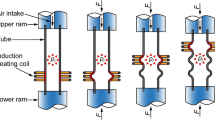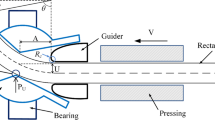Abstract
Tubular joint forming by elastomeric bulging (EB) is a feasible way to connect aluminum alloy tubes to high-strength sleeve fittings. It is critical to fully and deeply understand the deformation-induced sealing performance of tubular joints for precise manufacturing of high performance tubular joints. In this paper, thin-walled AA6061-T4 tubular joints fabricated by EB was investigated experimentally and numerically. Firstly, the anisotropic AA6061-T4 tube, the polyurethane elastomer (PUE) tube with hyperelasticity and the 15-5PH stainless steel (SS) sleeve fitting were characterized and modeled. Compared with the explicit algorithm, the implicit axisymmetric finite element (FE) models of the whole joining process, including EB forming and springback, were established. The influence of the groove structure of the sleeve fitting on the shearing-related pull-out strength and sealing-related bonding strength was discussed, and then the reasonable sleeve fitting’s structure with two grooves was obtained. Thus, the accurate ranges of extrusion pressure and tube bulging heights were derived for precise control of forming quality. Finally, the experimental set-up and forming dies for EB joining tests were established, and the reliability of these parameters determined by the FE model was verified experimentally. It is concluded that the forming quality of this tubular joint can be controlled precisely based on FE modeling of whole joining process, and thin-walled AA6061-T4 tubular joint fabricated by EB has a reliable seal performance.



















Similar content being viewed by others
References
Li H, Fu MW (2019) Deformation-based processing of materials. Elsevier. https://doi.org/10.1016/C2017-0-01559-8
Yang H, Li H, Zhang Z, Zhan M, Liu J, Li G (2012) Advances and trends on tube bending forming technologies. Chin J Aeronaut 25(1):1–12. https://doi.org/10.1016/s1000-9361(11)60356-7
Wanhill R, Ashok B (2017) Shape memory alloys (SMAs) for aerospace applications. Aerospace Materials and Material Technologies. Springer, In, pp 467–481
Yang H, Li H, Ma J, Wei D, Chen J, Fu MW (2019) Temperature dependent evolution of anisotropy and asymmetry of α-Ti in thermomechanical working: Characterization and modeling. Int J Plast 2019:102650 (In press). https://doi.org/10.1016/j.ijplas.2019.102650
Li H, Wei D, Zhang HQ, Yang H, Zhang D, Li GJ (2019) Tooling design–related spatial deformation behaviors and crystallographic texture evolution of high-strength Ti-3Al-2.5 V tube in cold pilgering. Int J Adv Manuf Technol 104(5–8):2851–2862. https://doi.org/10.1007/s00170-019-04151-w
Wang HP, Lü P, Cai X, Zhai B, Zhao JF, Wei B (2020) Rapid solidification kinetics and mechanical property characteristics of Ni–Zr eutectic alloys processed under electromagnetic levitation state. Mater Sci Eng A 772:138660. https://doi.org/10.1016/j.msea.2019.138660
Feng ZY, Li H, Yang JC, Huang H, Li GJ, Huang D (2018) Macro‑meso scale modeling and simulation of surface roughening: Aluminum alloy tube bending. Int J Mech Sci 144:696–707. https://doi.org/10.1016/j.ijmecsci.2018.06.032
K-i M, Bay N, Fratini L, Micari F, Tekkaya AE (2013) Joining by plastic deformation. CIRP Ann 62(2):673–694. https://doi.org/10.1016/j.cirp.2013.05.004
Groche P, Wohletz S, Brenneis M, Pabst C, Resch F (2014) Joining by forming—a review on joint mechanisms, applications and future trends. J Mater Process Technol 214(10):1972–1994. https://doi.org/10.1016/j.jmatprotec.2013.12.022
Henriksen J, Nordhagen HO, Hoang HN, Hansen MR, Thrane FC (2015) Numerical and experimental verification of new method for connecting pipe to flange by cold forming. J Mater Process Technol 220:215–223. https://doi.org/10.1016/j.jmatprotec.2015.01.018
Przybylski W, Wojciechowski J, Klaus A, Marré M, Kleiner M (2006) Manufacturing of resistant joints by rolling for light tubular structures. Int J Adv Manuf Technol 35(9–10):924–934. https://doi.org/10.1007/s00170-006-0775-0
Weddeling C, Woodward ST, Marré M, Nellesen J, Psyk V, Tekkaya AE, Tillmann W (2011) Influence of groove characteristics on strength of form-fit joints. J Mater Process Technol 211(5):925–935. https://doi.org/10.1016/j.jmatprotec.2010.08.004
Gies S, Weddeling C, Marré M, Kwiatkowski L, Tekkaya AE (2012) Analytic prediction of the process parameters for form-fit joining by die-less hydroforming. Key Eng Mater 504-506:393–398. https://doi.org/10.4028/www.scientific.net/KEM.504-506.393
Zhang Q, Jin K, Mu D (2014) Tube/tube joining technology by using rotary swaging forming method. J Mater Process Technol 214(10):2085–2094. https://doi.org/10.1016/j.jmatprotec.2014.02.002
Yang JC, Li H, Huang D, Li GJ (2020) Deformation-based joining for high-strength Ti-3Al-2.5V tubular fittings based on internal roller swaging. Int J Mech Sci 171:105376. https://doi.org/10.1016/j.ijmecsci.2019.105367
Merklein M, Allwood JM, Behrens BA, Brosius A, Hagenah H, Kuzman K, Mori K, Tekkaya AE, Weckenmann A (2012) Bulk forming of sheet metal. CIRP Ann 61(2):725–745. https://doi.org/10.1016/j.cirp.2012.05.007
Alves LM, Martins PAF (2012) Tube branching by asymmetric compression beading. J Mater Process Technol 212(5):1200–1208. https://doi.org/10.1016/j.jmatprotec.2012.01.004
Zhang Q, Zhang Y, Cao M, Ben N, Ma X, Ma H (2016) Joining process for copper and aluminum tubes by rotary swaging method. Int J Adv Manuf Technol 89(1–4):163–173. https://doi.org/10.1007/s00170-016-8994-5
Alves LM, Gameiro J, Silva CMA, Martins PAF (2017) Sheet-bulk forming of tubes for joining applications. J Mater Process Technol 240:154–161. https://doi.org/10.1016/j.jmatprotec.2016.09.021
Alves LM, Afonso RM, Silva CMA, Martins PAF (2018) Joining tubes to sheets by boss forming and upsetting. J Mater Process Technol 252:773–781. https://doi.org/10.1016/j.jmatprotec.2017.10.047
Alves LM, Silva CMA, Martins PAF (2014) End-to-end joining of tubes by plastic instability. J Mater Process Technol 214(9):1954–1961. https://doi.org/10.1016/j.jmatprotec.2014.04.011
Yu H, Li J, He Z (2018) Formability assessment of plastic joining by compression instability for thin-walled tubes. Int J Adv Manuf Technol 97(9–12):3423–3430. https://doi.org/10.1007/s00170-018-2128-1
Alves LM, Silva CMA, Martins PAF (2017) Joining of tubes by internal mechanical locking. J Mater Process Technol 242:196–204. https://doi.org/10.1016/j.jmatprotec.2016.11.037
Thiruvarudchelvan S (2002) The potential role of flexible tools in metal forming. J Mater Process Technol 122(2–3):293–300
Girard AC, Grenier YJ, Mac Donald BJ (2006) Numerical simulation of axisymmetric tube bulging using a urethane rod. J Mater Process Technol 172(3):346–355. https://doi.org/10.1016/j.jmatprotec.2005.10.012
Ramezani M, Ripin ZM, Ahmad R (2009) Computer aided modelling of friction in rubber-pad forming process. J Mater Process Technol 209(10):4925–4934. https://doi.org/10.1016/j.jmatprotec.2009.01.015
Koubaa S, Belhassen L, Wali M, Dammak F (2017) Numerical investigation of the forming capability of bulge process by using rubber as a forming medium. Int J Adv Manuf Technol 92(5–8):1839–1848. https://doi.org/10.1007/s00170-017-0278-1
Belhassen L, Koubaa S, Wali M, Dammak F (2017) Anisotropic effects in the compression beading of aluminum thin-walled tubes with rubber. Thin-Walled Struct 119:902–910. https://doi.org/10.1016/j.tws.2017.08.010
Li H, Yang H, Lu RD, Fu MW (2016) Coupled modeling of anisotropy variation and damage evolution for high strength steel tubular materials. Int J Mech Sci 105:41–57. https://doi.org/10.1016/j.ijmecsci.2015.10.017
Hill R (1948) A theory of the yielding and plastic flow of anisotropic metals. Proc R Soc Lond A 193(1033):281–297
Hill R (1998) The mathematical theory of plasticity, vol 11. Oxford university press
Hepburn C (2012) Polyurethane elastomers. Springer Science & Business Media,
Diani J, Fayolle B, Gilormini P (2009) A review on the Mullins effect. Eur Polym J 45(3):601–612. https://doi.org/10.1016/j.eurpolymj.2008.11.017
Sasso M, Palmieri G, Chiappini G, Amodio D (2008) Characterization of hyperelastic rubber-like materials by biaxial and uniaxial stretching tests based on optical methods. Polym Test 27(8):995–1004. https://doi.org/10.1016/j.polymertesting.2008.09.001
Ogden RW (1972) Large deformation isotropic elasticity–on the correlation of theory and experiment for incompressible rubberlike solids. Proc R Soc Lond A 326(1567):565–584
Systèmes D (2014) Abaqus analysis user’s guide. Solid (Continuum) Elements 6
Park Y-B, Kim H-Y, Oh S-I (2005) Design of axial/torque joint made by electromagnetic forming. Thin-Walled Struct 43(5):826–844. https://doi.org/10.1016/j.tws.2004.10.009
Funding
The authors would like to thank the National Natural Science Foundation of China (51775441&51275415), Commercial Aircraft Research and Development Project of China (MJ-2016-G-64), the National Science Fund for Excellent Young Scholars (51522509), and Research Fund of the State Key Laboratory of Solidification Processing (NWPU) of China (KP201608).
Author information
Authors and Affiliations
Corresponding author
Additional information
Publisher’s note
Springer Nature remains neutral with regard to jurisdictional claims in published maps and institutional affiliations.
Rights and permissions
About this article
Cite this article
Yang, J., Li, H., Huang, D. et al. Forming of thin-walled AA6061-T4 tubular joint by elastomeric bulging: experiment and computation. Int J Adv Manuf Technol 107, 25–38 (2020). https://doi.org/10.1007/s00170-020-05006-5
Received:
Accepted:
Published:
Issue Date:
DOI: https://doi.org/10.1007/s00170-020-05006-5




